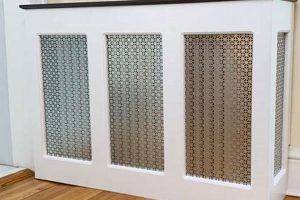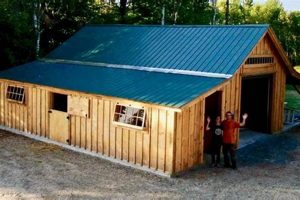A self-constructed hanging lamp offers a customizable and often cost-effective illumination solution for residential and commercial spaces. These fixtures, suspended from a ceiling, provide both ambient and task lighting, with designs ranging from simple bulb-and-cord arrangements to elaborate, multi-component constructions. For instance, repurposing a vintage mason jar and basic electrical components can yield a rustic, homemade lighting fixture.
The appeal of creating personalized overhead lighting stems from several factors, including budgetary considerations, creative expression, and the desire for unique home dcor. Historically, individuals crafted lighting fixtures out of necessity; however, contemporary motivations often involve upcycling materials, reducing waste, and achieving a distinctive aesthetic unattainable through mass-produced products. This approach can significantly reduce expenses compared to purchasing commercially available alternatives and allows for precise tailoring to existing interior design schemes.
The subsequent sections will delve into the materials, tools, techniques, and safety precautions required for successful self-assembly of such lighting arrangements. These details will include guidance on wiring, fixture mounting, and design considerations for achieving optimal illumination and visual appeal in various settings.
Essential Considerations for Home-Assembled Hanging Lamps
The successful creation and installation of self-made suspended luminaires necessitate careful planning and execution. The following points offer guidance to ensure both functional effectiveness and safety.
Tip 1: Electrical Safety is Paramount: Prior to commencing any wiring activities, disconnect the power supply at the circuit breaker. Employ a non-contact voltage tester to confirm the absence of current. If unfamiliar with electrical work, consult a qualified electrician.
Tip 2: Select Appropriate Materials: Choose components, including wire, sockets, and ceiling canopies, that are rated for the intended wattage and voltage. Ensure compatibility with local electrical codes and regulations. The selection of inferior materials can lead to overheating and fire hazards.
Tip 3: Plan the Design and Measurements: Accurately measure the desired drop length and spacing of the fixture. This is crucial for achieving balanced illumination and preventing obstructions within the space. Consider the height of the ceiling and the intended use of the room.
Tip 4: Secure Wiring Connections: Utilize wire connectors (wire nuts or terminal blocks) to create secure and insulated connections. Loose or poorly insulated connections can result in short circuits and electrical shocks. Double-check all connections for integrity.
Tip 5: Ensure Adequate Ventilation: If the design incorporates an enclosure around the bulb, provide adequate ventilation to prevent heat buildup. Overheating can reduce bulb lifespan and potentially damage the fixture itself. Test for excessive heat after installation.
Tip 6: Proper Mounting and Support: The ceiling-mounted canopy must be securely attached to a structural support, such as a ceiling joist. Use appropriate hardware, such as screws or bolts, depending on the ceiling material. An inadequately supported fixture can pose a falling hazard.
Tip 7: Consider the Light Source: Select bulbs with appropriate color temperature and light output to suit the intended function of the space. LED bulbs offer energy efficiency and longevity compared to incandescent options. Research the desired lighting effect before making a selection.
Adherence to these guidelines contributes to a safe, functional, and aesthetically pleasing finished product. Thorough planning and careful execution are essential for the successful completion of a self-made suspended lighting project.
The subsequent section will address specific design considerations and techniques to enhance the aesthetic appeal of these projects.
1. Safety Precautions
The intersection of self-assembled hanging lights and rigorous safety protocols is not merely advisable but fundamentally essential. The inherent risk of electrical shock, fire, and structural failure necessitates a comprehensive understanding and diligent application of safety measures. Specifically, the process of wiring, even in seemingly simple designs, introduces the potential for hazardous conditions if performed improperly. For instance, failing to adequately secure wire connections can lead to arcing, generating heat sufficient to ignite nearby materials. Similarly, selecting components with inadequate voltage or wattage ratings creates a risk of overheating and electrical component breakdown, potentially leading to fire.
The importance of stringent safety measures extends beyond the immediate installation phase. Over time, vibrations, temperature fluctuations, and other environmental factors can compromise the integrity of connections and mounting hardware. Regular inspection and maintenance are thus vital to identify and rectify potential hazards before they escalate into serious incidents. Consider a scenario where a homeowner, lacking sufficient electrical knowledge, attempts to modify an existing fixture. The introduction of incompatible components or incorrect wiring practices could compromise the fixture’s insulation, creating a pathway for electrical current to leak and pose a significant shock risk. Furthermore, the structural integrity of the mounting mechanism must be meticulously assessed to ensure it can support the weight of the completed light fixture, preventing potential collapse.
In conclusion, meticulous adherence to safety precautions is not a supplementary consideration but rather an integral component of self-assembled suspended lighting projects. The potential for electrical hazards, structural instability, and fire necessitates a thorough understanding of electrical principles, proper material selection, and diligent installation practices. Prioritizing safety ensures not only the functional effectiveness of the lighting fixture but also protects the occupants of the space from potential harm.
2. Material Selection
The selection of appropriate materials is a critical determinant of the functionality, safety, and aesthetic appeal of any self-constructed suspended lighting fixture. The chosen materials directly influence the longevity of the fixture, its ability to withstand environmental factors, and compliance with relevant safety standards. Neglecting material considerations can compromise the integrity of the entire project, leading to premature failure or hazardous conditions.
- Electrical Component Ratings
Electrical components, including wiring, sockets, and switches, must possess adequate voltage and amperage ratings to safely handle the intended load. Undersized components can overheat, posin
g a fire hazard and potentially damaging connected devices. For example, using 18-gauge wire for a high-wattage bulb could lead to insulation breakdown and electrical shorts. Selecting UL-listed components ensures adherence to recognized safety standards. - Structural Integrity
The materials used for the fixture’s frame, shade, and suspension system must provide sufficient structural support to prevent collapse. The weight of the lighting fixture, including the bulb, should be considered when choosing materials. Using lightweight but strong materials like metal or reinforced plastics can ensure stability. For instance, a glass shade requires a robust frame to prevent shattering or detachment.
- Heat Resistance and Dissipation
Materials used in proximity to the light source must exhibit high heat resistance to prevent deformation, discoloration, or combustion. Proper heat dissipation is crucial for extending the lifespan of the bulb and preventing overheating of nearby components. Metal or ceramic materials are often preferred in close proximity to the bulb. The design should allow for adequate airflow to dissipate heat effectively. Example: using a plastic socket too close to a halogen bulb.
- Material Compatibility and Durability
The materials chosen should be compatible with the intended environment and resistant to degradation from exposure to moisture, UV radiation, or other environmental factors. Exterior fixtures require weather-resistant materials to prevent corrosion or deterioration. Incompatible materials can react with each other, leading to premature failure. For instance, combining certain metals can cause galvanic corrosion. Also, wood and cloth elements should have flame retardant properties.
The careful selection of materials, considering electrical ratings, structural integrity, heat resistance, and environmental compatibility, is essential for creating a durable, safe, and visually appealing self-constructed suspended lighting fixture. The ultimate success of the project hinges on the proper choice and application of appropriate materials.
3. Wiring Techniques
The process of constructing a self-made suspended light fixture inextricably links to precise and safe wiring techniques. Incorrect wiring presents immediate hazards, including electrical shock and fire. The electrical circuit must be correctly assembled to ensure proper functionality and prevent damage to the connected components. A foundational understanding of basic electrical principles, such as series and parallel circuits, is essential for determining the appropriate wiring configuration. For example, if a fixture requires multiple bulbs, wiring them in parallel ensures that the failure of one bulb does not interrupt the circuit and extinguish the remaining lights. The improper grounding of a fixture constitutes a significant safety risk, potentially causing electrocution should a fault occur. Proper grounding directs stray current to the earth, preventing it from passing through a person.
Implementation of correct wiring necessitates the utilization of appropriate tools and materials. Wire strippers, wire connectors, and electrical tape are indispensable for creating secure and insulated connections. The gauge of the wire must correspond to the amperage of the circuit; using undersized wire can result in overheating and fire. Furthermore, adherence to established wiring color codes is critical for maintaining consistency and preventing confusion. Typically, black wires are used for the hot (live) conductor, white wires for the neutral conductor, and green or bare copper wires for the ground conductor. The use of terminal blocks or wire nuts is essential for creating secure and insulated connections between wires. These connectors prevent the wires from loosening over time, which could lead to arcing and electrical hazards. When connecting wires to a socket or switch, ensure that the connections are tight and that no exposed wire is visible.
In summary, proficiency in wiring techniques is not merely a skill but a prerequisite for the safe and successful creation of any self-made suspended lighting fixture. The risks associated with improper wiring are substantial, ranging from minor electrical malfunctions to life-threatening hazards. A thorough understanding of electrical principles, proper tool usage, and adherence to established safety protocols are paramount. Regular inspection and maintenance of the wiring connections are also crucial for ensuring the continued safe operation of the fixture.
4. Design Aesthetics
The aesthetic design of a self-constructed suspended light fixture is a critical factor influencing its overall impact and integration within a given space. The visual properties of the lighting element significantly contribute to the ambience and style of a room, affecting perceptions of size, warmth, and sophistication. The aesthetic value is not merely superficial; it directly correlates with the fixture’s ability to complement or enhance the existing decor. A poorly designed light, even if functionally sound, can detract from the overall aesthetic appeal of a room. For example, a modern, minimalist interior would clash with a highly ornate, traditionally styled hanging lamp, creating visual disharmony. Conversely, a well-considered design can elevate the space, acting as a focal point and contributing to a cohesive design scheme.
Practical considerations also play a significant role in aesthetic design. The size and shape of the fixture should be proportionate to the dimensions of the room and the height of the ceiling. A large, imposing light in a small room can overwhelm the space, making it feel cramped. Similarly, a small, understated fixture in a large room might appear insignificant and fail to provide adequate illumination. The choice of materials, finishes, and colors should align with the existing color palette and architectural style of the space. Using complementary colors and textures can create visual interest and enhance the overall design aesthetic. For instance, a rustic, industrial-themed interior might benefit from a pendant light constructed from reclaimed wood and exposed metal, while a more contemporary space might call for a sleek, minimalist design with clean lines and neutral colors.
In summation, the design aesthetic of a self-constructed hanging light is inextricably linked to its functional and visual success. Prioritizing design considerations ensures that the fixture not only provides illumination but also enhances the overall aesthetic appeal of the space. Challenges arise in balancing personal preferences with established design principles, requiring a careful assessment of the room’s existing decor and the intended atmosphere. The successful integration of a self-made lighting element into a space is a testament to the power of thoughtful design and its ability to transform a functional object into a work of art.
5. Bulb Compatibility
Bulb compatibility represents a critical intersection between electrical safety, fixture longevity, and desired illumination characteristics within the realm of self-assembled suspended lighting. The selection of an inappropriate bulb for a sp
ecific fixture can lead to a cascade of negative consequences, ranging from diminished light output and premature bulb failure to overheating and potential fire hazards. The cause-and-effect relationship is direct: incorrect bulb selection initiates a chain of events that compromises the safety and functionality of the entire lighting system. For instance, installing a high-wattage incandescent bulb in a fixture designed for lower wattage can generate excessive heat, melting the socket and potentially igniting surrounding materials. Alternatively, employing a non-dimmable LED bulb with a dimmer switch can result in flickering, buzzing, and ultimately, bulb failure.
The importance of bulb compatibility extends beyond mere safety considerations; it also directly impacts the energy efficiency and overall cost-effectiveness of the lighting system. Using a bulb with an inappropriate base type renders the fixture unusable. Choosing an incorrect voltage rating results in immediate failure or potential damage to the fixture. The careful selection of a bulb that matches the fixture’s specifications optimizes energy consumption and maximizes the lifespan of the bulb. A real-life example involves replacing an old incandescent bulb with a compatible LED alternative. The LED bulb not only consumes significantly less energy but also lasts considerably longer, reducing both energy bills and maintenance costs. Furthermore, the color temperature of the bulb significantly impacts the ambiance of the space. A warm white bulb creates a cozy and inviting atmosphere, while a cool white bulb provides brighter and more focused illumination, suitable for task lighting.
In conclusion, understanding bulb compatibility is paramount for the successful creation and operation of self-assembled suspended lighting fixtures. Failing to adhere to specified wattage, voltage, and base type requirements can lead to safety hazards, reduced efficiency, and diminished aesthetic appeal. This understanding is not merely theoretical; it has practical significance in everyday applications, ensuring both the longevity and safe operation of self-made illumination systems. Challenges in achieving optimal compatibility may arise from a lack of clear labeling on fixtures or inaccurate information regarding bulb specifications, highlighting the need for careful research and diligent selection.
6. Fixture Mounting
The secure and stable attachment of a self-constructed suspended lighting fixture, referred to as fixture mounting, constitutes a critical stage in the overall project. Proper mounting techniques ensure the safe operation of the lighting system and prevent potential hazards associated with detachment or collapse.
- Ceiling Joist Identification and Reinforcement
Locating ceiling joists is paramount for providing a solid anchor point. The use of a stud finder aids in identifying these structural members. If the desired mounting location does not align with a joist, supplemental bracing or a mounting plate spanning multiple joists may be required to distribute the weight and ensure structural integrity. Ignoring this step can lead to the fixture pulling away from the ceiling over time.
- Hardware Selection and Compatibility
The choice of mounting hardware, including screws, bolts, and anchors, must be appropriate for the ceiling material and the weight of the fixture. Hollow ceilings require specialized anchors capable of expanding and gripping the back of the drywall or plaster. Insufficient hardware can result in the fixture falling, causing damage or injury. The hardware must also be compatible with the canopy or mounting plate of the fixture itself.
- Wiring Access and Safety
Before commencing any mounting activities, the electrical circuit supplying the intended location must be de-energized at the breaker panel. Safe access to the wiring is crucial. The wiring must be properly insulated and protected within the junction box. Ensuring adequate wire length allows for safe and easy connection to the fixture. Improperly handled wiring can result in electrical shock or short circuits.
- Canopy Attachment and Security
The canopy, which conceals the wiring and mounting hardware, must be securely attached to the ceiling. The fit should be snug and flush, preventing gaps that could expose wiring or compromise the aesthetic appearance. Over-tightening the mounting screws can damage the ceiling or the canopy itself. A secure canopy attachment ensures the long-term stability and visual appeal of the installation. It should also resist vibration from movement or airflow.
These considerations underscore the critical role of meticulous fixture mounting in the successful implementation of a self-made suspended lighting solution. Each facet contributes to the overall safety and functionality of the project, demonstrating that proper mounting is integral to both the aesthetic and practical aspects of DIY suspended luminaires.
7. Code Compliance
Adherence to relevant electrical codes and safety standards is a non-negotiable aspect of constructing and installing self-made suspended lighting fixtures. These codes, established by local and national authorities, are designed to safeguard individuals and property from potential hazards associated with electrical installations. Failure to comply with these regulations can result in fines, legal liabilities, and, more importantly, increased risk of fire, electrical shock, or other accidents.
- Wiring Standards and Practices
Electrical codes mandate specific wiring methods, including wire gauge, insulation type, and connection techniques. For instance, the National Electrical Code (NEC) stipulates the use of appropriately sized conductors for the intended load, ensuring that wires can safely carry the required current without overheating. Additionally, approved wiring practices, such as the proper use of wire connectors and the secure routing of wires within enclosures, are essential for preventing short circuits and ground faults. Disregarding these standards can lead to dangerous conditions and potential property damage. For example, improper connections can lead to arcing which generates extreme heat.
- Fixture Listing and Certification
Many jurisdictions require that electrical fixtures, including pendant lights, be listed and certified by a recognized testing laboratory, such as UL (Underwriters Laboratories) or ETL (Edison Testing Laboratories). This certification indicates that the fixture has been tested and meets established safety standards. Using unlisted or non-certified fixtures can invalidate insurance claims in the event of an electrical incident. Self-constructed fixtures may not readily qualify for certification, necessitating careful selection of components and adherence to all applicable safety requirements.
- Grounding and Bonding Requirements
Proper grounding and bonding are critical for preventing electrical shock hazards. Electrical codes mandate that all metal parts of a lighting fixture be grounded to provide a low-resistance path for fault current to return to the source. This grounding helps to trip circuit breakers or ground fault circuit interrupters (GFCIs) in the event of a fault, minimizing the risk of electrocution. Grounding requirements vary depending on the type of wiring system and the location of the fixture
; for instance, fixtures installed in damp or wet locations often require enhanced grounding measures. If grounding is not applied correctly, potential shock hazard can appear in daily usage. - Clearances and Mounting Regulations
Electrical codes specify minimum clearances for lighting fixtures from combustible materials and other objects. These clearances are designed to prevent overheating and reduce the risk of fire. Mounting regulations dictate how fixtures must be securely attached to the ceiling or wall to prevent them from falling. For example, fixtures must be supported by structural members or approved mounting hardware capable of withstanding the weight of the fixture. It is particularly important to note the proper clearances if the light fixture is to be in a closet.
Compliance with electrical codes is an indispensable consideration for self-constructed suspended lighting projects. While the allure of customization and cost savings may be tempting, neglecting safety standards can have severe consequences. The careful review and application of relevant codes, combined with the use of certified components and safe wiring practices, are essential for ensuring the safety and longevity of self-made lighting installations. Failure to meet these standards not only jeopardizes personal safety but also undermines the integrity and value of the project.
Frequently Asked Questions
The following section addresses common inquiries and concerns related to the design, construction, and installation of self-assembled suspended lighting fixtures. The responses aim to provide clear and concise information for informed decision-making.
Question 1: Are self-constructed pendant lights safe for residential use?
The safety of self-constructed pendant lights hinges directly on adherence to electrical codes and proper construction techniques. Employing certified components, ensuring secure wiring connections, and adhering to wattage limitations are essential for mitigating potential hazards. Improperly constructed lights can pose fire and shock risks.
Question 2: What are the primary advantages of creating a pendant light fixture independently?
The primary advantages include design customization, cost-effectiveness, and the opportunity to utilize recycled or repurposed materials. Independent construction allows for tailored aesthetic integration within specific environments and offers potential cost savings compared to commercially available options.
Question 3: What tools are typically required for pendant light construction?
Essential tools include wire strippers, screwdrivers (various sizes), pliers, a voltage tester, and potentially a drill (depending on the design). Precision and safety necessitate the use of properly insulated tools and adherence to established safety protocols.
Question 4: How does one ensure proper grounding of a self-made pendant light?
Proper grounding requires connecting the metal components of the fixture to the grounding wire of the electrical circuit. This provides a safe path for fault current, minimizing the risk of electrical shock. Consult local electrical codes for specific grounding requirements.
Question 5: What are the most common mistakes encountered during pendant light construction?
Common mistakes include using undersized wiring, failing to secure connections adequately, neglecting grounding requirements, and exceeding the wattage rating of the fixture. Careful attention to detail and thorough understanding of electrical principles are crucial for avoiding these pitfalls.
Question 6: How is compliance with local electrical codes verified for a self-constructed pendant light?
Verification often requires inspection by a qualified electrical inspector. Contacting the local building department or electrical authority is advisable to determine specific requirements and inspection procedures.
Key takeaways include the paramount importance of safety, the benefits of customization, and the necessity of code compliance. Diligence and expertise contribute to the successful and safe implementation of self-made lighting solutions.
The subsequent section explores advanced design considerations and creative approaches for developing unique and aesthetically compelling self-made suspended lighting designs.
DIY Pendant Light
The preceding exploration of “diy pendant light” has illuminated critical facets, encompassing safety protocols, material selection, wiring techniques, design aesthetics, bulb compatibility, fixture mounting, and code compliance. These elements represent interdependent considerations that collectively determine the success and safety of any self-assembled suspended lighting project. Neglecting any single facet can compromise the overall integrity of the endeavor, potentially leading to hazardous conditions or functional deficiencies.
Therefore, the pursuit of crafting personalized illumination solutions necessitates a commitment to both knowledge acquisition and meticulous execution. The information presented serves as a foundation for informed decision-making, urging practitioners to prioritize safety, adhere to established standards, and approach each project with diligence and respect for the inherent risks associated with electrical work. Only through such comprehensive understanding can the creation of unique and aesthetically pleasing “diy pendant light” be achieved responsibly and sustainably.






![DIY Build: Circular Saw Crosscut Jig PDF Plans [Free] The DIY Hub: Creative Crafts, Repairs & Life Hacks DIY Build: Circular Saw Crosscut Jig PDF Plans [Free] | The DIY Hub: Creative Crafts, Repairs & Life Hacks](https://craftingdiycenter.com/wp-content/uploads/2025/07/th-5916-300x200.jpg)
